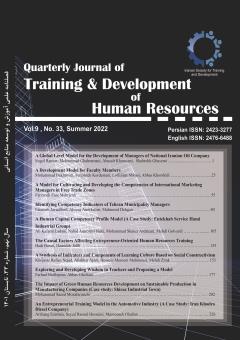Designing of an entrepreneurial educational model in the automotive industry: Iran khodro diesel
Subject Areas :arzhang ezatinia 1 , sayed rassul hosseini 2 , Masome Oladian 3
1 -
2 - ----
3 - ---------------
Keywords: Education, Entrepreneurship, Automotive, Entrepreneurial Education,
Abstract :
This research has been organized with the aim of designing an entrepreneurial educational model in the automotive industry, which is a mixed research (quantitative and qualitative) in terms of purpose, application and in terms of how to collect information. The statistical population in the qualitative section includes academic and organizational experts including industrial experts such as education supervisors training liaisons, training instructors, thematic experts in the company such as welding experts and in the quantitative part includes all Iran Khodro Diesel automotive training staff . The sample size in the qualitative part with theoretical saturation (20 people) was estimated using purposive sampling and in the quantitative part based on Cochran's formula 127 people was estimated by stratified random sampling.was confirmed by calculating the trough and the validity of the questionnaire was confirmed by calculating the square root of the AVE. The reliability of the questionnaire was obtained through Cronbach's alpha for the whole questionnaire of 0.968. Lisrel and smartpls3 software were used to analyze the data. The results identified 23 components and 133 indicators that learners 'personal characteristics (0.173), teachers' personal characteristics (0.171), educational content (0.169), industry-university interaction (0.167), teaching methods (0.157), support Senior manager (0.156), leadership and management style (0.143), space and educational equipment (0.124) according to their factor load, respectively, components have an impact on entrepreneurial education. Outcomes include commitment (0.745), satisfaction (0.670), employee self-efficacy (0.655), innovation (0.647), employee empowerment (0636), performance (0.603), and organizational agility (0.568), respectively. The proposed model had a good degree of fit
- احمدپور داریـانی (1380)، کـارآفرینی و نـقش آن در اقـتصاد مـلی، مـجموعه مقالات همایش کارآفرینی و فناوریهای پیشرفته تهران، تهران: انتشارات دانشگاه تهران.
- احمدپور داريانـي، مـحمـود و مـقيمـي ، مـحمـد (١٣٨٥)، مـبـاني کــارآفريني، تهـران: انتشارات فرانديش.
- احمدپور محمود و همکاران (1378) ، پروژه بررسی تجارب موفق،سیاستها وبـرنامهها و اقـدامات ده کـشور جهان در زمینه توسعه و ترویج کارآفرینی.
- آقـاجانی، عـلی اکـبر و مـدهوشی، مـهرداد (1386)، بررسی و تبیین مـوانع داخـلیکارآفرینی سازمانی، تهران، همایش ملی کارآفرینی، خلاقیت و سازمانهای آینده.
- سخدری ، کمال و فروزانفر ، حمید ( 1397 ) ، عوامل موثر برکارآفرینی سازمانی ، مقاله ارائه شده در دومین کنفرانس بین المللی مدیریت کسب و کار .
- الوانی ، سید مهدی و همکاران ( 1395 ) عوامل موثر بر کارآفرینی سازمانی ( مورد مطالعه صنایع غذایی ) فصلنامه علمی – پژوهشی مطالعات مدیریت ( بهبود و تحول ) ، شماره 82.
- پرهیزگار، محمد مهدی، درینی، محمدولی، آقاجانی افروزی، علی اکبر (1391)، مدل¬یابی کار آفرینی سازمان در بانک رفاه کارکنان استان مازندران، برنامه¬ریزی رفاه و توسعه اجتماعی، شماره 13، صص. 191-222.
- دامغانی، مریم، عبدلی، غلامرضا، بهمن پور، هومن ( 1396)، بازشناسی دیدگاه کارشناسان و فعالان محیط زیست نسبت به جایگاه حقوقی و نقش سازمان¬های مردم نهاد (NGOs) محیط زیستی در کشور ، مدیریت توسعه، شماره 6، صص. 9-22.
- رضواني، مهران, يدالهي فارسي، جهانگير, واحدوحدت كار، مهدي (1389)، پيامدهاي راهبرد كارآفريني سازماني در سازمانهاي عمومي غيردولتي، چشم انداز مديريت دولتي، دوره 1 , شماره 4 ، صص. 119-142.
- رستمی، ولی؛ حسینی پور، سید مجتبی. (1388). سازمانهای غیردولتی. فصلنامه حقوق، مجله دانشکدهی حقوق و علوم سیاسی، دوره 39، شمارهی 4، زمستان 1388، صص 191-211.
- رمضانی قوام آبادی، محمد حسین (1394)، مطالعه تطبیقی وضعیت حقوقی سازمانهای مردم نهاد در ایران و فرانسه؛ از تاسیس تا فعالیت، مطالعات حقوق تطبیقی، شماره 10، صص. 541-568.
- Adams, Lewis M. (1968), webster`s new dictionary, Book Inc., publishers: New York Entrepreneurship and venture. - Austin, J.; Stevenson, H.; Wei-Skillern, J. (2006), Social and Commercial Entrepreneurship: Same, Different, or Both? Entrepreneurship theory and practice, 30 (1): 1-22. - Bornstein, D. (2004), How to change the world? , ISF 100E, Cambridge. - Cherrier, Helene, Goswami, Paromita, Ra, Subhasis (2017), Social entrepreneurship: Creating value in the context of institutional complexity, Journal of Business Research, 10: 1-14. - Dees J, Emerson J, Economy P (2001), Enterprising Nonprofits. - Drucker, Pete, F. (2007), Innovation and Entrepreneurship. - Entrepreneurship in vocational schools: Turkey case, Procedia Social and Behavioral Sciences, 2: 1849–1854. - Harris, Jared D., Sapienza, Harry J., Bowie, Norman E. (2009), Ethics and entrepreneurship, Journal of Business Venturing, 24: 407–418. - Hsu, Chin-Chun, Tan, Keah Choon, Laosirihongthong, Tritos, Leong, Keong (2011), Entrepreneurial SCM competence and performance of manufacturing SMEs, International Journal of Production Research, 49(22): 6629–6649 - Jackson, Chad, Eyal ori & Inbar Dan (2003), developing a public School entrepreneurship inventory, International Journal of Entrepreneurial Behavior & Research, 9(6). - Koh Hian, chye (1996), Testing hypothesis of entrepreneurial characteristics, Journal of Managerial Psychology, 11(3). - Kuratko, G., McMullen, Jeffery, S., Hornsby, Jeffrey S. (2017), Is your organization conducive to the continuous creation of social value? Toward a social corporate entrepreneurship scale, Business Horizons: 60, 271—283. - MEYER, CARRIE A. (1995), Opportunism and NGOs: Entrepreneurship and Green North-South Transfers, World Development, 23(8): 1277-1289. - Morris Michael &; Lewis Pamela (1995), The determinants of entrepreneurial activity: implication for marketing, European Journal of Marketing, 29(7). - Morrison Alison (2000), Entrepreneurship: What triggers it? International Journal of Entrepreneurial Behavior & Research, 6(2). - Prokopenko Joseph &; Pavlin Igor (1991), Entrepreneurship development in public enterprises, Geneva: International Labour office. - Rosenbloom David (1989), public Administration: understanding Management politics and law in the Public sector, Random House. - Seeling Tina (2003), High Technology Entrepreneurship Education: STVP and REE, Sao Paulo: Stan fird Technology Ventures Program. - Soysekerci, Serhat, Erturgut, Ramazan (2010), Improvement of non-governmental organization entrepreneurship in vocational schools: Turkey case, Elsevier Procedia - Social and Behavioral Sciences, 2(2): 1849-1854.


